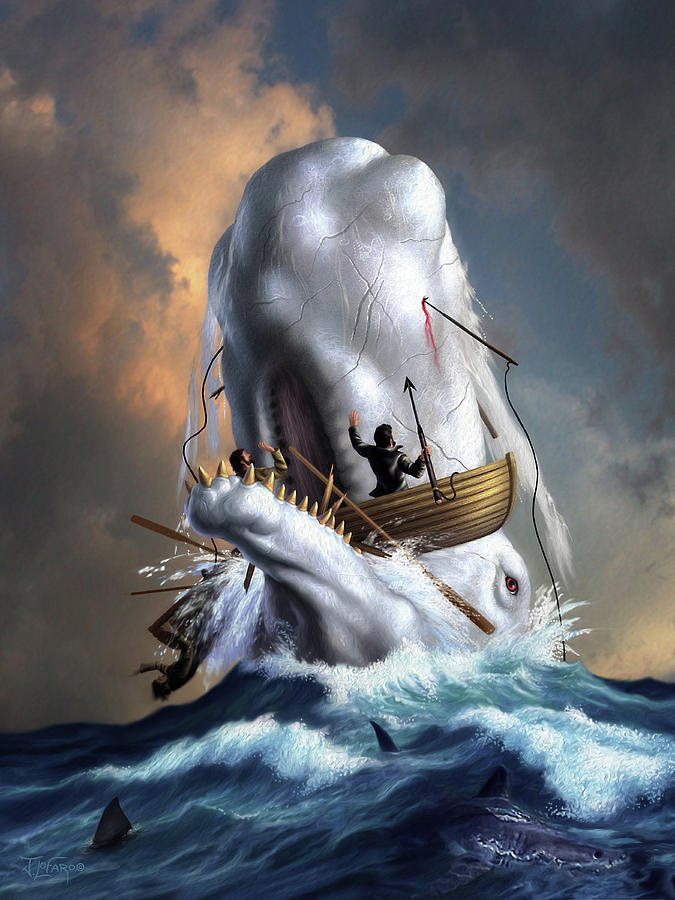Herman Melville’s Moby Dick and Whaling
Large expanses of water are so mysterious and precious that they cannot be fully investigated so far. There are a lot of organisms living in water that are part of nature. Instead of taking care of the habitat of those living creatures, people keep tampering with nature and damaging it. One of the illuminating literary examples of this issue is depicted in Herman Melville’s Moby Dick.
Moby Dick is Great American Novel written in 1851. Vengeful Captain Ahab is ‘determined to kill the whale that sank his previous ship, and severed his leg at the knee’ (Leadbeater, 2016) . Melville’s sea is not a simple background; it is a full participant of the action intruding into man’s consciousness. Take, for example, Ishmael, the narrator, who is going on ‘whaling voyage’ (Melville, 1851) :
Chief among these motives was the overwhelming idea of the great whale himself. Such a portentous and mysterious monster roused all my curiosity. Then the wild and distant seas where he rolled his island bulk; the undeliverable, nameless perils of the whale; these, with all the attending marvels of a thousand Patagonian sights and sounds, helped to sway me to my wish. … I love to sail forbidden seas, and land on barbarous coasts. …. By reason of these things, then, the whaling voyage was welcome; the great flood-gates of the wonder-world swung open, and in the wild conceits that swayed me to my purpose, two and two there floated into my inmost soul, endless processions of the whale, and, mid most of them all, one grand hooded phantom, like a snow hill in the air. (p.16)
Besides, Melville also argues for the necessity of water imagery in art: Ishmael focuses the reader’s attention on an artist who ‘desires to paint you the dreamiest, shadiest, quietest, most enchanting bit of romantic landscape’ (Youree, 2010, p. 7) .
On the contrary, for the Captain Ahab, the sea is ‘a battleground on which he will die’ (Youree, 2010, p. 20) . The characters of the novel are led astray in the fog; they are wandering around the sea and losing hope for rescue: ‘Soon we were running through a suffusing wide veil of mist; neither ship nor boat to be seen. … Meanwhile the boat was still booming through the mist, the waves curling and hissing around us like the erected crests of enraged serpents’ (Melville, 1851, p. 235)
‘The most dramatic performance of the sea occurs at the very end of the novel as it swallows up the Pequod and her crew’ (Forray, p. 9) . Thus, pursue for killing Moby Dick fails: the characters suffer a defeat either psychologically or physically. All in all, the sea is free and independent; its soul embodied with Moby Dick triumphs over people’s aggression and anger: the ship perishes and the magnificent White whale vanishes.

https://static.theworks.co.uk/images/9781853260087_Z.jpg

https://media.pri.org/s3fs-public/styles/story_main/public/sea.jpg?itok=dZKd3KJ_

https://images.fineartamerica.com/images/artworkimages/mediumlarge/1/moby-dick-1-jerry-lofaro.jpg
The novel concerns such pivotal issue as whaling. Whales are marine mammals that have been undergoing this activity for a long time. For instance, whaling for commercial purposes is widespread. In Japan, meat from the whales is sold in food markets; in Iceland, around three percent of Icelanders eat whale meat regularly (Meet Us Don't Eat Us: Campaign to take whale meat off the menu for tourists, 2018). According to the statistics, in the North Pacific, Japanese whalers can kill up to 200 minke whales, 50 Bryde's, 100 sei whales and 10 sperm whales under the guise of scientific research (Which countries are still whaling? 2018). In order to educate tourists about whale meat consumption, ‘Meet Us Don´t Eat Us’ campaign was launched in Reykjavík in the summer of 2010 (Meet Us Don't Eat Us: Campaign to take whale meat off the menu for tourists, 2018). Besides, whales may be disturbed by the approaching boats which are too noisy, fast, and close to whales (Disturbance by whale-watching boats, 2018); moreover, collisions between whales and ships may be extremely harmful for both mammals and people on board.

https://img.kyodonews.net/english/public/images/posts/18a57e846085bf6e907a7b837a9fb3a4/cropped_image_l.jpg

https://www.orcaweb.org.uk/media/zoo/images/threats-whaling-01_fb7b8227b9681e85a3945cc9326bd7ab.jpg
To regulate the process of whaling, the International Whaling Commission (IWC) was signed in Washington, D.C., United States, on December 2, 1946, the principles of which ‘provide for the complete protection of certain species; designate specified areas as whale sanctuaries; set limits on the numbers and size of whales which may be taken; prescribe open and closed seasons and areas for whaling; and prohibit the capture of suckling calves and female whales accompanied by calves’ (International Whaling Commission, n.d.).
Jon Lien (2010), the researcher, states that the repetitive disturbance of whales may result in harmful repercussions on health of whales, their survival, and reproduction (Disturbance by whale-watching boats). All in all, not only several regulating campaigns towards whaling are crucial, but also people’s respect of these creatures.

https://insideclimatenews.org/sites/default/files/styles/colorbox_full/public/Delphinapterus_leucas_2.jpg?itok=PgX3QSDR
Anastasia Gretšiškina



Comments
Post a Comment